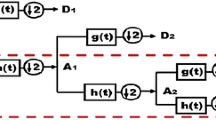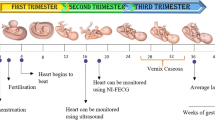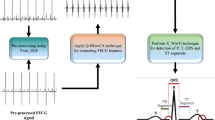Abstract
Purpose
Non-invasive fetal electrocardiography (fECG) offers crucial information for assessing early diagnosis of fetal distress and morbidity. However, the non-invasive fECG signals probably contain various non-stationary noises, which may generate a bad influence on signal processing. Signal quality assessment plays a crucial role in accurate feature estimation for obtaining high-quality signals.
Methods
This study develops a comprehensive framework for the assessment of signal quality for non-invasive fECG signals. Firstly, the ECG collection equipment is employed to gather abdominal ECG signal data from eight pregnant women in the hospital. Secondly, signal preprocessing is operated including signal segmentation and data normalization process. Subsequently, a total of thirty-seven signal quality indexes (SQIs) are extracted which consist of the amplitude-based SQI, R-wave-based SQI, statistical-based SQI, fractal dimension SQI, power spectrum distribution-based SQI, and entropy domain-based SQI. Then, in order to reduce the dimensionality of features and improve the experimental performance, information gain is carried out to identify the subset of the optimal features. At last, the classifier combines different feature numbers to classify the quality of the non-invasive fECG signal.
Results
Ten classifiers are selected to perform a classification task between good-quality and bad-quality abdominal signals. The experimental results show that the combination of twenty-four effective features and random forest achieved the highest classification outcome, which in terms of the ACC, and F1 scores are 0.9508, and 0.9510, respectively.
Conclusion
The experimental results indicate that our work can reliably assess the signal quality for non-invasive fECG signals and filter out good-quality signals. This proposed algorithm can help to improve the accuracy of fetal signal extraction and fetal heart rate estimation for further analysis, which is beneficial to promoting fetal health monitoring.







Similar content being viewed by others
Data Availability
Not applicable.
Code Availability
References
Xu, L., et al. (2020). Simulator of a full fetal Electrocardiogram Measurement Chain by Multichannel Capacitive Sensing. IEEE Transactions on Instrumentation and Measurement, 69, 4348–4357. https://doi.org/10.1109/TIM.2019.2947979.
Varanini, M., et al. (2017). A new method for QRS complex detection in multichannel ECG: Application to self-monitoring of fetal health. Computers in Biology and Medicine, 85, 125–134. https://doi.org/10.1016/j.compbiomed.2016.04.008.
Kovacs, F., Torok, M., & Habermajer, I. (2000). A rule-based Phonocardiographic Method for long-term fetal heart rate monitoring. IEEE Transactions on Biomedical Engineering, 47, 124–130. https://doi.org/10.1109/10.817627.
Keenan, E., Karmakar, C., Brownfoot, F. C., & Palaniswami, M. (2021). Personalized anatomic modeling for noninvasive fetal ECG: Methodology and applications. IEEE Transactions on Instrumentation and Measurement, 70, 1–12. https://doi.org/10.1109/TIM.2021.3069028.
Zhang, Y., et al. (2022). Wearable fetal ECG monitoring system from Abdominal Electrocardiography Recording. Biosensors, 127, 475. https://doi.org/10.3390/bios12070475.
Liu, F., et al. (2018). Dynamic ECG Signal Quality evaluation based on the generalized bSQI index. Ieee Access : Practical Innovations, Open Solutions, 6, 41892–41902. https://doi.org/10.1109/ACCESS.2018.2860056.
Andreotti, F., Gräßer, F., Malberg, H., & Zaunseder, S. (2017). Non-invasive fetal ECG Signal Quality Assessment for Multichannel Heart Rate Estimation. IEEE Transactions on Biomedical Engineering, 64, 2793–2802. https://doi.org/10.1109/TBME.2017.2675543.
Karimi, A., Setarehdan, S. K., & Araabi, B. N. (2017). A PCA/ICA based Fetal ECG Extraction from Mother Abdominal Recordings by Means of a Novel Data-driven Approach to Fetal ECG Quality Assessment. Journal of biomedical physics and engineering, 7, 37–50.
Zhong, W., Liao, L., & Guo, X. (2018). A Deep Learning Approach for fetal QRS Complex Detection. Physiological Measurement, 39, 045004. https://doi.org/10.1088/1361-6579/aab297.
Mertes, G., et al. (2022). A Deep Learning Approach for the Assessment of Signal Quality of Non-invasive Foetal Electrocardiography. Sensors (Basel, Switzerland), 9, 3033. https://doi.org/10.3390/s22093303.
Shi, X., Yamamoto, K., Ohtsuki, T., Matsui, Y., & Owada, K. (2022). Non-invasive Fetal ECG Signal Quality Assessment based on Unsupervised Learning Approach. In 2022 44th Annual International Conference of the IEEE Engineering in Medicine & Biology Society (EMBC), 1296–1299.
Jarchi, D., Prochazka, A., & Sanei, S. (2020). A New Spectrum Driven Index for the Assessment of ECG Signal Quality. In 2020 42nd Annual International Conference of the IEEE Engineering in Medicine & Biology Society (EMBC), 1–4.
Faskhodi, M., & García-González, M. A. (2022). Using Signal Quality Assessment (SQA) to Help Sleep Stage Classification. In 2022 Computing in Cardiology (CinC), 1–4.
Satija, U., Ramkumar, B., & Manikandan, M. S. (2018). A review of signal processing techniques for electrocardiogram signal quality assessment. IEEE Reviews Biomed Eng, 11, 36–52.
Gala, M., Barabas, J., & Krajnak, J. (2020). Robust QRS complex detector algorithm based on modified Pan-Tompkins method and wavelet transform. In 2020 43rd International Conference on Telecommunications and Signal Processing (TSP), 633–636.
Lopez-Caracheo, F. (2018). Fractal Dimension-based Methodology for Sudden Cardiac Death Prediction. In 2018 IEEE International Autumn Meeting on Power, Electronics and Computing (ROPEC), 1–6.
Clifford, G. D., Lopez, D., Li, Q., & Rezek, I. (2011). Signal quality indices and data fusion for determining acceptability of electrocardiograms collected in noisy ambulatory environments. Computing in Cardiology, 38, 1.
Nooralishahi, P., Loo, C. K., & Shiung, L. W. (2019). Robust remote heart rate estimation from multiple asynchronous noisy channels using Autoregressive Model with Kalman Filter. Biomedical Signal Processing and Control, 47, 366–379. https://doi.org/10.1016/j.bspc.2018.09.007.
Cooley, J. W., & Tukey, J. W. (1965). An algorithm for the machine calculation of Complex Fourier Series. Mathematics of Computation, 19(90), 297–301.
Liu, C., et al. (2019). Signal Quality Assessment and Lightweight QRS Detection for Wearable ECG SmartVest System. IEEE Internet of Things Journal, 6, 1363–1374. https://doi.org/10.1109/JIOT.2018.2844090.
Zhang, Y., Zhang, Y., Lo, B., & Xu, W. (2020). Wearable ECG Signal Processing for Automated Cardiac Arrhythmia classification using CFASE-based feature selection. Expert Systems, 37, e12432. https://doi.org/10.1111/exsy.12432.
Liu, C., et al. (2014). A multi-step method with Signal Quality Assessment and fine-tuning Procedure to locate maternal and fetal QRS complexes from Abdominal ECG recordings. Physiological Measurement, 35, 1665–1683. https://doi.org/10.1088/0967-3334/35/8/1665.
Zhang, H., Ren, Y., & Yang, X. (2013). Research on Text Feature Selection Algorithm Based on Information Gain and Feature Relation Tree. In 2013 10th Web Information System and Application Conference, 446–449.
Mahajan, R., Kamaleswaran, R., Howe, J. A., & Akbilgic, O. (2017). Cardiac Rhythm Classification from a Short Single Lead ECG Recording via Random Forest. In 2017 Computing in Cardiology (CinC), 1–4.
Emanet, N. (2009). ECG Beat Classification by Using Discrete Wavelet Transform and Random Forest Algorithm. In 2009 Fifth International Conference on Soft Computing, Computing with Words and Perceptions in System Analysis, Decision and Control, 1–4.
Mendez, M. O., Bianchi, A. M., Matteucci, M., Cerutti, S., & Penzel, T. (2009). Sleep apnea screening by Autoregressive models from a single ECG lead. IEEE Transactions on Biomedical Engineering, 56, 2838–2850. https://doi.org/10.1109/TBME.2009.2029563.
Patil, R., & Barkade, V. M. (2018). Class-Specific Features Using J48 Classifier for Text Classification. In 2018 Fourth International Conference on Computing Communication Control and Automation (ICCUBEA), 1–5.
Escalona-Morán, M. A., Soriano, M. C., Fischer, I., & Mirasso, C. R. (2015). Electrocardiogram classification using Reservoir Computing with Logistic Regression. IEEE Journal of Biomedical and Health Informatics, 19, 892–898. https://doi.org/10.1109/JBHI.2014.2332001.
Yang, G., Zhao, Y., & Gu, X. (2021). A novel bayesian Framework with enhanced principal component analysis for Chemical Fault diagnosis. IEEE Transactions on Instrumentation and Measurement, 70, 1–9. https://doi.org/10.1109/TIM.2020.3034975.
Abdel-Galil, T. K., Sharkawy, R. M., Salama, M. M. A., & Bartnikas, R. (2005). Partial discharge pattern classification using the fuzzy decision Tree Approach. IEEE Transactions on Instrumentation and Measurement, 54, 2258–2263. https://doi.org/10.1109/TIM.2005.858143.
Verma, A., & Saha, R. (2022). Analysis of BayesNet Classifier for DDoS Detection in Vehicular Networks. In 2022 International Conference on Augmented Intelligence and Sustainable Systems (ICAISS), 980–987.
Melgani, F., & Bazi, Y. (2008). Classification of Electrocardiogram signals with support Vector machines and particle swarm optimization. IEEE Transactions on Information Technology in Biomedicine, 12, 667–677.
Mao, Y. M., & Chang, T. C. (2019). ECG Automatic Identification Method based on BP Neural. In 2019 IEEE International Conference on Computation, Communication and Engineering (ICCCE), 109–112.
Pourbabaee, B., Roshtkhari, M. J., & Khorasani, K. (2018). Deep convolutional neural networks and learning ECG features for Screening Paroxysmal Atrial Fibrillation patients. IEEE Transactions on Systems Man and Cybernetics: Systems, 48, 2095–2104. https://doi.org/10.1109/TSMC.2017.2705582.
Prabhat, N., & Kumar Vishwakarma, D. (2020). Comparative Analysis of Deep Convolutional Generative Adversarial Network and Conditional Generative Adversarial Network using Hand Written Digits. In 2020 4th International Conference on Intelligent Computing and Control Systems (ICICCS), 1072–1075.
Veretelnikova, E. L., & Elantseva, I. L. (2016). Selection of Factor for Root Mean Square Minimum Error Criterion. In 2016 13th International Scientific-Technical Conference on Actual Problems of Electronics Instrument Engineering (APEIE), 221–223.
Thirumalai, C., Kanimozhi, R., & Vaishnavi, B. (2017). Data Analysis Using Box Plot on Electricity Consumption. In 2017 International conference of Electronics, Communication and Aerospace Technology (ICECA), 598–600.
Giulia, B., Eleonora, S., & Rik, V. (2023). Automatic signal quality assessment of raw trans-abdominal biopotential recordings for non-invasive fetal electrocardiography. Frontiers in Bioengineering and Biotechnology, 6, 1–11. https://doi.org/10.3389/fbioe.2023.1059119.
Acknowledgements
The authors appreciate the support from the Southeast–Lenovo Wearable Heart-Sleep-Emotion Intelligent Monitoring Lab.
Funding
This research was funded by the National Natural Science Foundation of China (62171123, 62071241, 62101120, 62201144, and 62211530112), the Natural Science Foundation of Jiangsu Province (BK20210208, BE2022160), the Young Elite Scientists Sponsorship Program by CAST (2022QNRC001), and Ministry of Education’s Chunhui Jihua Cooperative Research Project (HZKY20220155).
Author information
Authors and Affiliations
Contributions
Yuwei Zhang, Aihua Gu, and Chengyu Liu designed the experiment. Yuwei Zhang, Zhijun Xiao, Caiyun Ma, and Zhongyu Wang conducted the experiments. Yuwei Zhang and Chengyu Liu drafed the paper. Chenxi Yang, Lina Zhao, and Jianqing Li refined the manuscript. Lina Zhao, Jianqing Li, and Chengyu Liu provided the experiment equipment and project support. All the authors contributed to the result presentation and discussion.
Corresponding authors
Ethics declarations
Author Contributions
Yuwei Zhang, Aihua Gu, and Chengyu Liu designed the experiment. Yuwei Zhang, Zhijun Xiao, Caiyun Ma, and Zhongyu Wang conducted the experiments. Yuwei Zhang and Chengyu Liu drafted the paper. Chenxi Yang, Lina Zhao, and Jianqing Li refined the manuscript. Lina Zhao, Jianqing Li, and Chengyu Liu provided the experiment equipment and project support. All the authors contributed to the result presentation and discussion.
Competing interests
The authors declare no conflict of interest.
Ethical Approval
The protocol of this study was approved by the Ethics Committee of the Jiangsu Provincial People’s Hospital.
Consent to Participate
Written informed consent was given by all participants in accordance with the Declaration of Helsinki.
Additional information
Publisher’s Note
Springer Nature remains neutral with regard to jurisdictional claims in published maps and institutional affiliations.
Rights and permissions
Springer Nature or its licensor (e.g. a society or other partner) holds exclusive rights to this article under a publishing agreement with the author(s) or other rightsholder(s); author self-archiving of the accepted manuscript version of this article is solely governed by the terms of such publishing agreement and applicable law.
About this article
Cite this article
Zhang, Y., Gu, A., Xiao, Z. et al. An Integrated Framework for Assessing the Quality of Non-invasive Fetal Electrocardiography Signals. J. Med. Biol. Eng. 44, 114–126 (2024). https://doi.org/10.1007/s40846-024-00852-0
Received:
Accepted:
Published:
Issue Date:
DOI: https://doi.org/10.1007/s40846-024-00852-0




